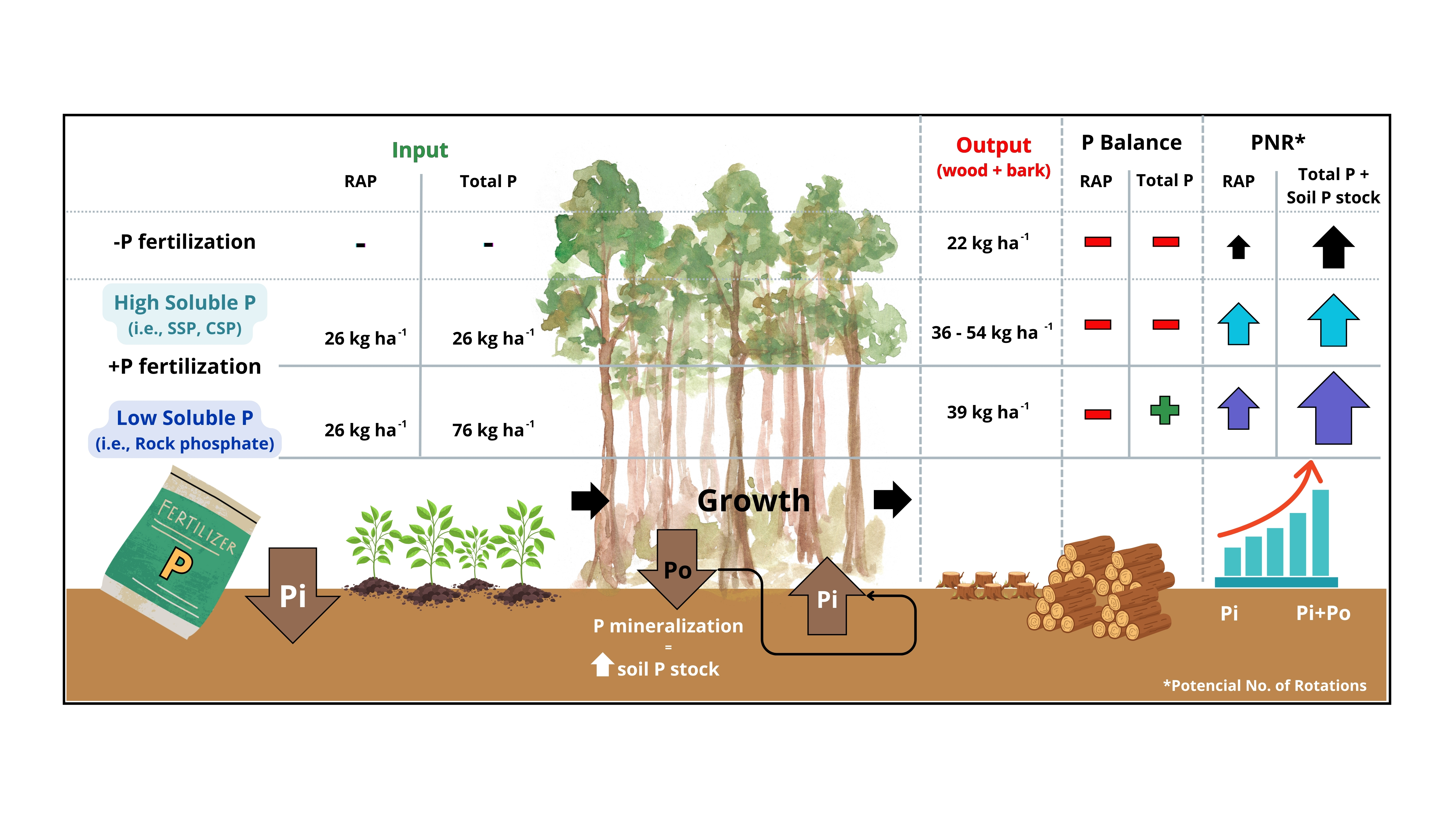Phosphate fertilizer solubility affects the P use efficiency and the sustainability of wood production by Eucalyptus stands
06/Nov/2025
ABSTRACT Eucalyptus genus exhibits high nutrient use efficiency, but the phosphorus (P) balance in the soil under Eucalyptus stands is often negative, mainly due to higher P exportation in the wood after forest harvesting when compared with fertilization inputs. We evaluated the effect of phosphate fertilizers with varying solubilities and technologies on P balance and use efficiency in Eucalyptus, focusing on organic P (Po) mineralization. A randomized complete block design, with four blocks and six treatments, was used to test […]
Chemical, Biological, and Biochemical Parameters of the Soil P Cycle After Long-Term Pig Slurry Application in No-Tillage System
30/Oct/2017
ABSTRACT In Southern Brazil, agricultural soils are often treated over long periods with annual pig slurry (PS) applications, and their influence on soil nutrient dynamics should be monitored. This study aimed to evaluate the P forms accumulated in the soil and some biological and biochemical parameters of the P cycle after 19 successive PS applications over eight years, in a no-tillage (NT) system. Pig slurry was applied at rates of 0, 20, 40, and 80 m3 ha-1 per crop. Several […]
Phosphorus Forms in Ultisol Submitted to Burning and Trituration of Vegetation in Eastern Amazon
06/Apr/2016
ABSTRACT The use of fire to prepare agricultural areas is a technique still used by small farmers in eastern Amazon. This type of management changes the dynamics of soil nutrients, especially phosphorus, which constitutes the most limiting nutrient for crop production in tropical soils. This study was carried out to evaluate changes in phosphorus forms in an Argissolo Amarelo Distrófico (Ultisol) submitted to burning and trituration of secondary forest in eastern Amazon. The evaluated systems were: slash-and-burn of vegetation; slash-and-mulch […]
Forms of phosphorus in an oxisol under different soil tillage systems and cover plants in rotation with maize
01/Jun/2014
Phosphorus fractions play a key role in sustaining the productivity of acid-savanna Oxisols and are influenced by tillage practices. The aim of this study was to quantify different P forms in an Oxisol (Latossolo Vermelho-Amarelo) from the central savanna region of Brazil under management systems with cover crops in maize rotation. Three cover crops (Canavalia brasiliensis, Cajanus cajan (L.), and Raphanus sativus L.) were investigated in maize rotation systems. These cover crops were compared to spontaneous vegetation. The inorganic forms […]
Spectroscopic quantification of soil phosphorus forms by 31p-nmr after nine years of organic or mineral fertilization
01/Jun/2013
Long-standing applications of mineral fertilizers or types of organic wastes such as manure can cause phosphorus (P) accumulation and changes in the accumulated P forms in the soil. The objective of this research was to evaluate the forms of P accumulated in soils treated with mineral fertilizer or different types of manure in a long-term experiment. Soil was sampled from the 0-5 cm layer of plots fertilized with five different nutrient sources for nine years: 1) control without fertilizer; 2) […]
Phosphorus transformation in poultry litter and litter-treated Oxisol of Brazil assessed by 31P-NMR and wet chemical fractionation
01/Nov/2012
Large quantities of poultry litter are being produced in Brazil, which contain appreciable amounts of phosphorus (P) that could be of environmental concern. To assess the immediate environmental threat, five poultry litters composed of diverse bedding material were incubated for 43 days under greenhouse conditions. The litters consisted of: coffee bean husk (CH); wood chips (WC); rice husk (RH); ground corn cobs (CC) and ground napier grass (NG) (Pennisetum purpureum Schum.), in which the change in forms of soluble P […]
Effects of burning and grazing on microbial phosphorus in natural grassland soils
01/Oct/2011
In natural grassland ecosystems deficient in available P, the temporary immobilization of P in microbial biomass and its subsequent mineralization can be considered a potential mechanism of P supply to plants. The purpose of this study was to evaluate the influence of burning and grazing of grassland vegetation on the dynamics of soil P, with emphasis on the content of P immobilized in microbial biomass. The treatments consisted of the combination of grazing (presence or absence) and burning (presence or […]
Soil phosphorus fractions in sandy soils amended with cattle manure for long periods
01/Jun/2009
Phosphorus fractions were determined in soil samples from areas fertilized or not with farmyard cattle manure (FYM) and in samples of FYM used in the semi-arid region of Paraiba state, Brazil. Soil samples were taken from the 0-20; 20-40 and 40-60 cm layers of 18 cultivated areas, which, according to interviews with farmers, had been treated with 12 to 20 t ha-1 FYM annually, for the past 2 to 40 years. Soil samples were also collected from four unfertilized pasture […]
Phosphorus fractions in soil cultivated with corn as affected by different phosphates and application methods
01/Apr/2008
The land use history and management of fertilization influence the soil phosphorus supply capacity. In this study, the P fractions in a Red Argisol (Ultissol) of the cerrado region were evaluated under different application methods and with phosphorus sources of different solubility, after three successive corn crops. The area had already been fertilized and cultivated in the past and remained covered with Brachiaria grass. A randomized block design with four replications was used, in a 4 x 3 + 1 factorial scheme, involving four […]
Bioavailability of soil phosphorus forms in no-tillage system
01/Aug/2007
The addition of fertilizers to the soil increases P contents in many forms of different bond energies with soil colloids. This has been observed in the soil surface layer under no tillage system, however there is little information about the availability of these P forms to plants. The study aimed to evaluate the bioavailability of P forms of a soil under no tillage with P applications. Samples were collected (0-10 cm) in a Rhodic Hapludox that had been fertilized with […]

